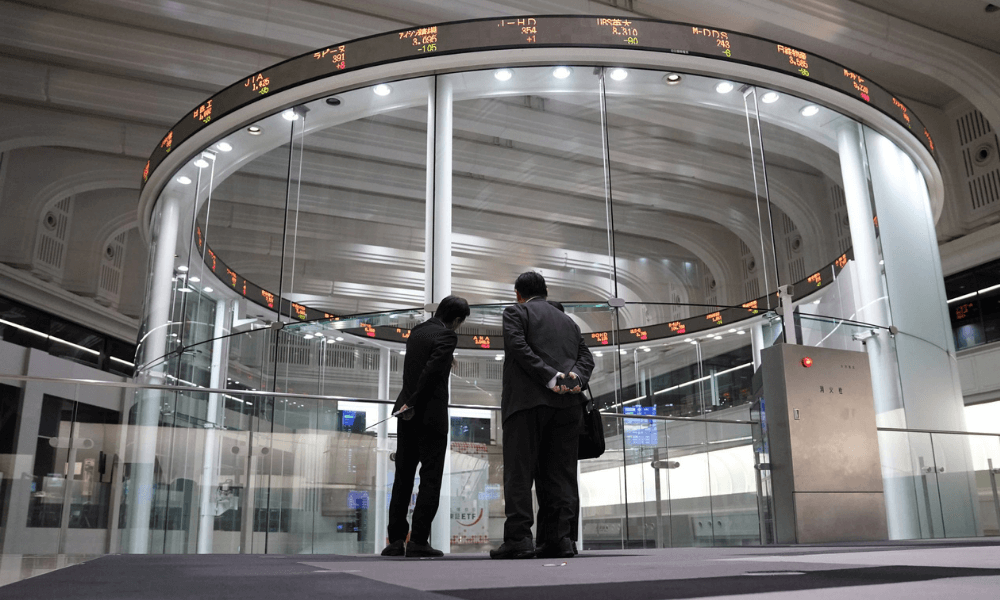
On Monday, Asian stocks fell as investors awaited a Federal Reserve meeting at which the central bank is anticipated to announce that it will soon begin draining the enormous pool of liquidity that has fueled growth stocks in recent years.
Concerns about a possible Russian strike on Ukraine heightened the caution, with the US State Department removing family members of its diplomatic workers in Kyiv.
According to the New York Times, President Joe Biden is considering sending tens of thousands of US troops, as well as warships and planes, to NATO allies in Europe.
EUROSTOXX 50 futures declined 0.4 percent in Europe, while FTSE futures fell 0.2 percent.
However, following last week's thrashing, Wall Street futures have rebounded, with the S& P 500 futures up 0.7 percent and the Nasdaq futures up 0.8 percent.
Markets are already putting in a slight likelihood that the Fed would raise rates this week, despite the overwhelming anticipation of a first hike to 0.25 percent in March and three more to 1.0 percent by the end of the year.
"With inflation so high," said Oliver Allen, a market economist at Capital Economics, "the Fed is on track to gradually withdraw the ultra-accommodative monetary policy that has been a key prop to stock values for over a decade."
With their high valuations, the potential of increasing borrowing costs and more appealing bond yields has taken a toll on tech stocks, with the Nasdaq down 13% this year and the S&P 500 down roughly 8%.
The sell-off was worsened by a nearly 22% drop in Netflix (NASDAQ:NFLX), which lost $44 billion in market value as a result of a bleak estimate for membership growth.
Because of the magnitude of the losses, Treasuries surged late last week on expectations that the market meltdown would scare the Fed into being less hawkish, a variant of the old Greenspan put.
Despite the recent downturn, Allen pointed out that the S&P 500 was still 40% higher than where it closed 2019, and the Nasdaq was 60% higher.
"This time around, investors may not be able to rely on a so-called 'Fed put,' given that the central bank's tightening cycle has only just begun, and the strength of the US economy suggests that even tighter policy is necessary."
Indeed, the first estimate of US GDP for the December quarter is anticipated this week, with growth expected to reach 5.4 percent on an annualized basis before Omicron slammed the brakes.
The earnings season is also well underway, with IBM (NYSE:IBM), Microsoft (NASDAQ:MSFT), Johnson & Johnson (NYSE:JNJ), Tesla (NASDAQ:TSLA), and Apple (NASDAQ:AAPL) all reporting this week (NASDAQ:AAPL).
This week, around a fifth of the S&P 500 is slated to submit quarterly updates.
While Treasuries rose late last week, 10-year rates are still up 22 basis points for the month at 1.77 percent, not far from early 2020 levels.
This rise has boosted the value of the US dollar, which gained 0.5 percent against a basket of currencies last week and is currently trading at 85.647. After failing to continue a recent surge to near $1.1500, the euro was stalled at $1.1324.
"The concern is that the Fed's announcement depicts a sense of urgency to act quickly, most likely in March, in the face of extremely high inflation," said Joseph Capurso, CBA's head of international economics.
"This could even encourage markets to price in the chance of a 50 basis point rate hike in March, and we predict a knee-jerk reaction above its 4 January high of 96.46 in that scenario."
As markets fall, the Japanese yen benefits from safe-haven flows, maintaining the dollar at 113.84, uncomfortably near to last week's low of 113.47.
After hitting a six-week high of $1,842 last week, gold held steady at $1,836 per ounce. [GOL/]
Oil prices were climbing again after reaching a seven-year high for the fifth week in a row on forecasts that demand would remain strong and supplies would be limited. [O/R]
Brent crude gained 83 cents to $88.72 a barrel, while US crude gained 77 cents to $85.91.Source